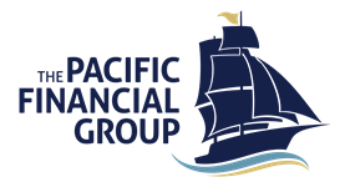The Pacific Financial Group, Inc.
The Pacific Financial Group is a financial advisor firm based in Bellevue, Washington, that works with individual and institutional clients. Portfolio management and financial planning are the focuses of the firm. It also boasts a nautical theme, as evidenced by the firm's logo.
The Pacific Financial Group has a fee-only structure, which means that all of its compensation comes from client-paid fees. On the other hand, a fee-based firm would earn sales commissions or other forms of compensation in addition to the fees that clients pay.
The Pacific Financial Group Background
The Pacific Financial Group was created in 1984 by James McClendon. Today, the firm is led by chief executive officer and board chair Megan P. Meade, who has been with the firm for more than 25 years. Meade owns a majority stake in the business through her control of Pacific Holdings Group, LLC.
The Pacific Financial Group employs a large team of over two dozen advisors. Across this team, you'll find certifications such as the chartered financial analyst (CFA), accredited investment fiduciary (AIF) and chartered alternative investment analyst (CAIA) designations.
The Pacific Financial Group Client Types and Minimum Account Sizes
When it comes to individual clients, The Pacific Financial Group primarily works with those below the high-net-worth threshold. Although these clients represent 98% of the firm's 20,000+ client base, the firm also manages money for corporations, charitable organizations and pensions and other retirement plans.
The firm has variable minimum account size requirements that depend on the services you're receiving. These range from no minimum at all to as much as $100,000. The firm reserves the right to waive these minimums.
Services Offered by The Pacific Financial Group
The Pacific Financial Group offers a range of different investment management services. With the firm's Strategy Plus and Self-Directed Brokerage Account-Strategy Plus Programs, clients receive portfolios consisting solely of PFG Funds, which are managed by an affiliate of the firm, Pacific Financial Group. With these, clients can choose between five different portfolios that vary in terms of risk tolerance.
Additionally, the firm provides several separately managed accounts (SMAs): Equity, Balanced, Income Cash Yield, Strategic Equity, Strategic Balanced, Strategic Moderate Growth and Capital Defender Asset Allocation. Clients can also take part in the firm's EPIC program, which provides access to institutional money managers. Finally, the firm can also manage certain retirement accounts and variable annuity sub-accounts.
The Pacific Financial Group Investment Philosophy
The Pacific Financial Group relies on modern portfolio theory when managing client portfolios. This diversification strategy looks to spread a client's funds across different asset classes to lower overall risk.
The firm additionally uses a proprietary risk management software called "RiskPro®" that's developed by one of the firm's affiliates. This program takes a client's answers to a risk tolerance questionnaire and attempts to forecast the kinds of returns they could earn.
Fees Under The Pacific Financial Group
The Pacific Financial Group typically charges its clients a percentage-based fee to have their assets managed by the firm. These rates will vary depending on the program in which you participate. Clients of the Strategy Plus Program and Self-Directed Brokerage Account-Strategy Plus Program will pay a 1.25% advisory fee, plus a 0.10% 12b-1 fee. Clients in the EPIC program typically pay an annual maximum program fee of 1.95%.
For SMA services, as well Core Retirement Optimization and Variable Annuity Optimization, clients will pay a fee to both the firm and any intermediary that initially referred them to the firm. These fees go as follows:
| Pacific Financial Group Investment Management Fees | |
| Assets Under Management | Fee Rates |
| Up to $500K | 1.00% |
| $500K - $3MM | 0.75% |
| $3MM - $5MM | 0.50% |
| $5MM - $10MM | 0.40% |
| Above $10MM | Negotiable |
Below is a breakdown of approximately how much you could pay in advisory fees for SMA, Core Retirement Optimization or Variable Annuity Optimization services:
| *Estimated investment management fees do not include brokerage, custodial, third-party manager or other fees, which can vary in amount. | |
| Estimated Investment Management Fees at The Pacific Financial Group* | |
| Your Assets | The Pacific Financial Group Fee Amount |
| $500K | $5,000 |
| $1MM | $8,750 |
| $5MM | $33,750 |
| $10MM | $53,750 |
What to Watch Out For
The Pacific Financial Group doesn't list any disclosures on its Form ADV.
Opening an Account With The Pacific Financial Group
If you're interested in becoming a client of The Pacific Financial Group, try calling the firm at (425) 451-7722. Alternatively, you can visit the firm’s website and fill out its contact form so an advisor can reach out to you personally.
All information is accurate as of the writing of this article.
Retirement Planning Tips
- Finding a financial advisor doesn’t have to be hard. SmartAsset’s free tool matches you with up to three vetted financial advisors who serve your area, and you can have a free introductory call with your advisor matches to decide which one you feel is right for you. If you’re ready to find an advisor who can help you achieve your financial goals, get started now.
- When you’re planning out your income for retirement, don’t forget to account for Social Security payments. Although Social Security won’t be enough to retire on, it can be a valuable addition to your existing retirement funds. To find out how much you’re in line to receive, stop by SmartAsset’s Social Security calculator.

